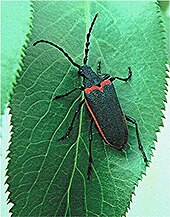Lepturinae
| Lepturinae | |
|---|---|

| |
| Central European Lepturini and Rhagiini with some anatomical details | |
| Scientific classification | |
| Domain: | Eukaryota |
| Kingdom: | Animalia |
| Phylum: | Arthropoda |
| Class: | Insecta |
| Order: | Coleoptera |
| Family: | Cerambycidae |
| Subfamily: | Lepturinae |
| Tribes | |
| Diversity | |
| 5–7 tribes About 150 genera | |
| Synonyms | |
| |

Lepturinae, the lepturine beetles, is a subfamily of the longhorn beetle family (Cerambycidae), containing about 150 genera worldwide. This lineage is most diverse in the Northern Hemisphere. Until recently the subfamily Necydalinae was included within the lepturines, but this has been recently recognized as a separate subfamily. Nine tribes are usually recognized today,[1] with a tenth, Caraphiini, created in 2016.[2] A few genera are of uncertain placement within the subfamily.
Usually among the smaller members of their family, these beetles are of a slender shape – particularly the thorax is markedly less wide than the wings, while the elytra tips are often pointed. They differ from most other longhorn beetles in that the antennae are not directly adjacent to the compound eyes. Hence, the latter are generally oval in outline, rather than having an indentation where the antennae originate, or even being divided by them. In addition, sexual dichromatism is not infrequently seen in lepturines; usually, longhorn beetles are not dimorphic or only have longer antennae in males.
Tribes and genera
Lepturinae contains the following genera:[2][1][3]



Tribe Caraphiini
- Caraphia Matsushita 1933 Noctileptura Chemsak & Linsley, 1984
Tribe Desmocerini Blanchard, 1845
- Desmocerus Dejean 1821
Tribe Encyclopini LeConte, 1873
Tribe Lepturini Latreille, 1802
Selected genera: (complete list is on the Lepturini page)
- Alosternida Podany 1961
- Analeptura Linsley & Chemsak 1976
- Anastrangalia Ohbayashi 1963
- Anoplodera Pic 1901
- Bellamira LeConte 1873
- Brachyleptura Casey 1913
- Cerrostrangalia Hovore & Chemsak 2005
- Charisalia Casey 1913
- Chontalia Bates 1872
- Choriolaus Bates 1885
- Cyphonotida Casey 1913
- Dorcasina Casey 1913
- Eurylemma Chemsak & Linsley 1974
- Euryptera Lepeletier & Audinet-Serville in Latreille 1828
- Fortuneleptura Villiers 1979
- Grammoptera Audinet-Serville 1835
- Idiopidonia Swaine & Hopping 1928
- Judolia Mulsant 1863
- Leptochoriolaus Chemsak & Linsley 1976
- Leptura Linnaeus 1758
- Lepturobosca (Cosmosalia) Casey 1913
- Lepturopsis Linsley & Chemsak 1976
- Lycidocerus Chemsak & Linsley 1976
- Lycochoriolaus Linsley & Chemsak 1976
- Lycomorphoides Linsley 1970
- Lygistopteroides Linsley & Chemsak 1971
- Macrochoriolaus Linsley 1970
- Megachoriolaus Linsley 1970
- Meloemorpha Chemsak & Linsley 1976
- Mimiptera Linsley 1961
- Mordellistenomimus Chemsak & Linsley 1976
- Nemognathomimus Chemsak & Linsley 1976
- Neoalosterna Podany 1961
- Neobellamira Swaine & Hopping 1928
- Neoleptura Thomson 1860
- Orthochoriolaus Linsley & Chemsak 1976
- Ortholeptura Casey 1913
- Pachytodes Pic 1891
- Pseudophistomis Linsley & Chemsak 1971
- Pseudostrangalia Swaine & Hopping 1928
- Pseudotypocerus Linsley & Chemsak 1971
- Pygoleptura Linsley & Chemsak 1976
- Stenelytrana Dejean 1837
- Stenostrophia Casey 1913
- Stenurella Rosenhauer, 1856
- Stictoleptura Casey 1924
- Strangalepta Casey 1913
- Strangalia Dejean 1835
- Strangalidium Giesbert 1997
- Strophiona Casey 1913
- Trachysida Casey 1913
- Trigonarthris Haldeman 1847
- Trypogeus Lacordaire, 1869
- Typocerus LeConte 1850
- Xestoleptura Casey 1913
Tribe Oxymirini Danilevsky, 1997
- Neoxymirus Miroshnikov 2013
- Oxymirus Mulsant 1862
Tribe Rhagiini Kirby, 1837
- Acmaeops LeConte 1850
- Acmaeopsoides Linsley & Chemsak 1976
- Akimerus Audinet-Serville, 1835
- Anthophylax LeConte 1850
- Apiocephalus Gahan, 1898
- Brachysomida Casey 1913
- Brachyta Fairmaire 1868
- Centrodera LeConte 1850
- Comacmaeops Linsley & Chemsak 1972
- Cortodera Mulsant 1863
- Enoploderes LeConte 1862
- Euracmaeops Danilevsky, 2014
- Evodinus LeConte 1850
- Gaurotes LeConte 1850
- Gnathacmaeops Linsley & Chemsak, 1972
- Metacmaeops Linsley & Chemsak 1972
- Neanthophylax Linsley & Chemsak 1972
- Pachyta Dejean 1821
- Pidonia Thomson 1864
- Piodes LeConte 1850
- Pseudogaurotina Plavilstshikov 1958
- Rhagium Fabricius 1775
- Stenocorus Reitter 1912
- Tomentgaurotes Podany 1962
Tribe Rhamnusiini Sama, 2009
- Neorhamnusium Hayashi 1976
- Rhamnusium Latreille 1829
Tribe Sachalinobiini Danilevsky, 2010
Tribe Teledapini Pascoe, 1871
Tribe Xylosteini Reitter, 1913
- Leptorhabdium Kraatz 1879
- Pseudoxylosteus Sama 1993
- †"Leptura" longipennis (nomen dubium; does not belong to Leptura)[4]
References
- ^ a b Bouchard, Patrice; Bousquet, Yves; Davies, Anthony E.; Alonso-Zarazaga, Miguel A.; et al. (2011). "Family-group names in Coleoptera (Insecta)". ZooKeys (88). Pensoft Publishers: 1–972. doi:10.3897/zookeys.88.807. ISSN 1313-2989. PMC 3088472. PMID 21594053.
- ^ a b Ohbayashi, Nobuo; Lin, Mei-Ying; Yamasako, Junsuke Yamasako (2016). "Revision of the Caraphiini, New Tribe (Coleoptera, Cerambycidae, Lepturinae)". Zootaxa. 4084 (2): 187–217. doi:10.11646/zootaxa.4084.2.2. PMID 27394259.
- ^ Bezark, Larry G. "A Photographic Catalog of the Cerambycidae of the New World". Archived from the original on 2019-07-19. Retrieved 2018-12-11.
- ^ Vitali, Francesco (2005). "Notes about European fossil Lepturinae and the description of a new species (Coleoptera, Cerambycidae, Lepturinae)". Lambillionea. CV (4): 530–538. CiteSeerX 10.1.1.626.9431.
 Media related to Lepturinae at Wikimedia Commons
Media related to Lepturinae at Wikimedia Commons Data related to Lepturinae at Wikispecies
Data related to Lepturinae at Wikispecies
